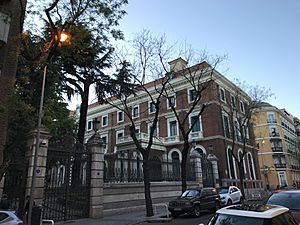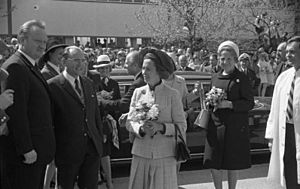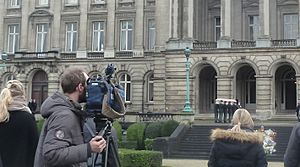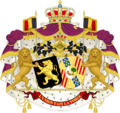Fabiola of Belgium facts for kids
Quick facts for kids Fabiola |
|
|---|---|

1960 photograph
|
|
| Queen consort of the Belgians | |
| Tenure | 15 December 1960 – 31 July 1993 |
| Born | Doña Fabiola Fernanda María-de-las-Victorias Antonia Adelaida de Mora y Aragón 11 June 1928 Zurbano Palace, Madrid, Spain |
| Died | 5 December 2014 (aged 86) Stuyvenberg Castle, Laeken, Brussels, Belgium |
| Burial | 12 December 2014 Church of Our Lady of Laeken |
| Spouse | |
| Father | Gonzalo de Mora y Fernández y Riera y del Olmo, Marqués de Casa Riera |
| Mother | Blanca de Aragón y Carrillo de Albornoz y Barroeta-Aldamar y Elío |
| Religion | Roman Catholicism |
Doña Fabiola Fernanda María-de-las-Victorias Antonia Adelaida de Mora y Aragón (born 11 June 1928 – died 5 December 2014) was the Queen of the Belgians. She became queen when she married King Baudouin in 1960. She remained queen until his death in 1993.
Queen Fabiola and King Baudouin did not have any children. After King Baudouin passed away, his younger brother, King Albert II, became the next king.
Contents
Early Life and Family
Fabiola de Mora y Aragón was born on 11 June 1928 in Madrid, Spain. Her birthplace was the Zurbano Palace, which was the home of her father, the Marqués de Casa Riera. Her parents were Don Gonzalo de Mora y Fernández y Riera y del Olmo and Doña Blanca de Aragón y Carrillo de Albornoz y Barroeta-Aldamar y Elío.
Fabiola was the fifth of seven children. One of her brothers was Jaime de Mora y Aragón. Before she became queen, Fabiola worked as a nurse in a hospital in Madrid. She also wrote a book of 12 fairy tales called Los doce cuentos maravillosos. One of these stories, "The Indian Water Lilies," even inspired a special part of the Efteling theme park in 1966.
Marriage to King Baudouin
Fabiola married Baudouin on 15 December 1960. He had been the King of the Belgians since 1951. Their wedding took place at the Cathedral of St. Michael and St. Gudula in Brussels. Fabiola wore a beautiful Art Deco tiara that was a gift to Baudouin's mother, Astrid of Sweden. Her wedding dress was designed by the famous fashion designer Cristóbal Balenciaga.
When she got engaged, Time magazine called Fabiola a "Cinderella Girl." In Spain, bakers created a special type of bread called "la fabiola" to honor her marriage. This bread is still made today.
In 1961, the explorer Guido Derom named a newly found mountain range in Antarctica the Queen Fabiola Mountains in her honor. Several types of ornamental plants are also named after her.
The royal couple wished to have children, but Queen Fabiola had five miscarriages between 1961 and 1968. She spoke openly about this in 2008, saying, "You know, I myself lost five children. You learn something from that experience. I had problems with all my pregnancies, but you know, in the end I think life is beautiful." She and King Baudouin believed these experiences helped them love all children even more. She was very involved in raising her husband's nephew and niece, Prince Philippe and Princess Astrid.
Queen's Activities and Work
Queen Fabiola was very active in many good causes. After Queen Elisabeth passed away in 1965, Queen Fabiola became the honorary president of the Queen Elisabeth Music Competition. She often attended the music competition's events.
In the 1990s, Queen Fabiola visited Hospital Saint-Pierre in Brussels, which was important for AIDS patients. She hugged a patient there, becoming one of the first public figures to show such support.
In September 1993, she became the president of the King Baudouin Foundation. This foundation was created to improve the lives of people in Belgium. Queen Fabiola also started the Social Secretariat of the Queen, which helped many people who asked for support. She supported programs to help children with dyslexia.
She also created the Queen Fabiola Fund for Mental Health, which helps people with mental health challenges. For her work, she received several awards, including the Ceres Medal in 2001 from the UN Food and Agriculture Organization.
Every year, Queen Fabiola attended the Summit on Economic Progress of Rural Women in Geneva. This summit aimed to bring together first ladies to help women in developing countries.
Life as Queen Dowager
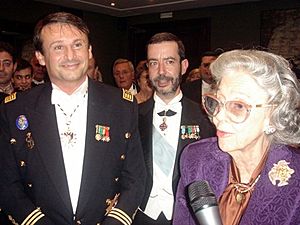
After King Baudouin died in July 1993, his younger brother, Albert II, became king. Fabiola moved from the Royal Castle of Laeken to a smaller home, Stuyvenberg Castle. She made fewer public appearances so that her sister-in-law, Queen Paola, could shine as the new queen.
Queen Fabiola was admired for her strong Roman Catholic faith and her work for social causes. She cared deeply about mental health, children's issues, and women's issues. In 2001, she received the Ceres Medal for her efforts to help rural women in developing countries.
In 2009, she received anonymous threats. She famously responded during Belgian National Day celebrations by waving an apple to the crowd, like in the William Tell story.
In 2013, there was some discussion about her plans to set up a private foundation. Some people thought it was a way to avoid paying taxes. However, Queen Fabiola denied this, saying, "I have never had the intention of depositing funds I received from the public purse with my foundation. All the monies that I receive from the civil list go on expenditure on my household. The lion's share goes on salaries."
Language Skills
Queen Fabiola was very good at languages. Besides her native Spanish, she could speak French, Dutch, English, German, and Italian.
Illness and Death
Queen Fabiola had health problems for many years, including osteoporosis. In January 2009, she was in the hospital for 15 days with a serious lung infection. She recovered, but her health remained fragile.
On the evening of 5 December 2014, the Royal Palace announced that Queen Fabiola had passed away at Stuyvenberg Castle.
Funeral
The Belgian government declared a period of national mourning from 6 December to 12 December. Queen Fabiola's funeral took place on 12 December at the Cathedral of St. Michael and St. Gudula in Brussels.
Her coffin was brought to the Royal Palace on 10 December. Many royal family members from around the world attended her funeral. These included the Grand Duke of Luxembourg, the Empress of Japan, the Queen of Denmark, the King and Queen of Sweden, the King of Norway, and the former King and Queen of Spain.
Images for kids
Titles and Honours
Titles and Styles
- 11 June 1928 – 15 December 1960: Doña Fabiola de Mora y Aragón
- 15 December 1960 – 31 July 1993: Her Majesty The Queen of the Belgians
- 31 July 1993 – 5 December 2014: Her Majesty Queen Fabiola of Belgium
Selected Honours
Queen Fabiola received many honors from Belgium and other countries for her dedication and service. Some of these include:
- Belgium: Knight Grand Cross of the Order of Leopold
- Vatican: Dame Grand Cross with Collar of the Order of the Holy Sepulchre
- Spain: Dame Grand Cross of the Order of Isabella the Catholic
- Thailand: Dame Grand Cordon with Chain of the Order of the Royal House of Chakri
See also
 In Spanish: Fabiola de Mora y Aragón para niños
In Spanish: Fabiola de Mora y Aragón para niños
- Belgian Vocation Foundation
- Queen Fabiola Foundation for Mental Health
- Queen Fabiola Mountains
- Indian Water-lilies


